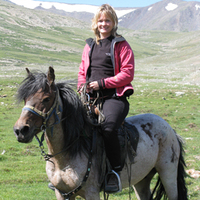Papers by Susan Gawarecki

Oak Ridge was the birthplace of nuclear research, and nuclear-reactor and fuel-cycle research are... more Oak Ridge was the birthplace of nuclear research, and nuclear-reactor and fuel-cycle research are historical missions at Oak Ridge National Laboratory (ORNL). The region is also home to the Tennessee Valley Authority (TVA), owner of six nuclear power plant units that generate 30% of the region’s electricity. Consequently, residents and local governments have a significant interest in the disposal of high-level radioactive waste (HLW) and spent nuclear fuel (SNF). The Oak Ridge Reservation (ORR) Local Oversight Committee (LOC) represents the concerns of local governments with respect to Department of Energy (DOE) environmental issues, including national policies such as disposal of DOE’s most dangerous wastes. ORNL has sent SNF to other DOE sites, and is shipping its transuranic (TRU) waste to the Waste Isolation Pilot Plant (WIPP). The LOC and its Citizens' Advisory Panel (CAP) supported the permitting of WIPP for disposal of TRU waste and the proposed use of Yucca Mountain for ...

Location map of study area. 6 2 Generalized bedrock geology of the White Cloud 9 Peaks area. 3 Gl... more Location map of study area. 6 2 Generalized bedrock geology of the White Cloud 9 Peaks area. 3 Glacial limits and moraine positions of the northeastern White Cloud Peaks area. 4 Railroad Ridge, view east from Silver Rule cirque. 24 5 Sketch of brown zone in landslide escarpment. 29 6 Transects and measured slopes of the Railroad Ridge 35 diamicton and bedrock surfaces. 7 Size distribution of five matrix samples. 41 8 Cumulative size percentage plot of the Railroad 47 Ridge diamicton and other diamictons. 9 (a) Mean versus standard deviation for the Railroad 48 Ridge diamicton and other diamictons. (b) Skewness versus standard deviation for the Railroad Ridge diamicton and other diamictons. 10 Reconstruction of the White Cloud Peaks region prior 64 to the valley cutting episode. 11 Isopach map of reconstructed Railroad Ridge diamicton 66 thickness. 12 Cross section of the reconstructed Railroad Ridge 69 diamicton and profiles of alluvial fans. 13 Idealized sequence of geomorphic events. 71 (a) Development of the post-Challis erosion surface. (b) Deposition of the Railroad Ridge diamicton. (c) Erosion of the modern valleys.

East Tennessee Technology Park (ETTP) in Oak Ridge, Tennessee is the site of the former K-25 gase... more East Tennessee Technology Park (ETTP) in Oak Ridge, Tennessee is the site of the former K-25 gaseous diffusion complex. One hundred eleven structures in this complex comprised the K-25 Site Main Plant and Powerhouse Historic Districts. The K-25 Building—the world’s first gaseous diffusion plant—has been designated a Manhattan Project Signature Facility. The U.S. Department of Energy (DOE) is cleaning up ETTP for private-sector reuse, which necessitates the demolition of all contaminated or decrepit facilities. The effect of the planned action on the structures in the historic district triggered the National Historic Preservation Act (NHPA) Section 106 process to determine how to best preserve and/or interpret the Manhattan Project facilities. Beginning in 2002, a series of Memorandums of Agreement (MOAs) were negotiated between DOE and several consulting and signatory parties. The first of these enabled a study to determine preservation options, to inventory and retrieve historic eq...
The stratigraphy of Iraq is marked by complex vertical and lateral facies sequences controlled pr... more The stratigraphy of Iraq is marked by complex vertical and lateral facies sequences controlled predominantly by two factors: (1) eustatic sea level variations, and (2) tectonic movements. Analysis of the sedimentary cycles provides a framework for evaluating the relative economic importance of transgressive versus regressive facies within the Iraq stratigraphic succession. Most reservoir rocks, principally reefal and neritic limestones and
Detailed topographic mapping of the Ras Issaran area along the west bank of the Gulf of Suez reve... more Detailed topographic mapping of the Ras Issaran area along the west bank of the Gulf of Suez reveals Quaternary faulting along preexisting trends, cross-fault reversals, and tectonically controlled sedimentation. The neotectonic fault systems of the region were identified and mapped by altimetry of selected bedrock units and Quaternary gravel surfaces. Tectonic activity in the Ras Issaran area is dominated by

Optical analysis of Landsat imagery is a valuable preliminary step for exploration in areas where... more Optical analysis of Landsat imagery is a valuable preliminary step for exploration in areas where a detailed geologic base is lacking, logistics are difficult, or the political situation is insecure. Two maps of Iraq produced by such analysis elucidate structural and lithologic relations across a broad oil-producing region. The Landsat map of Iraq is divided into units based on drainage patterns, surface textures, relative resistance to erosion, and color. These units tentatively correlate to the broadly generalized geologic map of Iraq. The Landsat map clearly delineates Iraq's 3 major geotectonic zones: desert and alluvial plains, simply folded, and overthrust. The Lineament and anomaly map, derived from optically enhanced imagery, shows noncultural lineaments and 5 types of anomalies: linear, circular, structural, textural, and shade. Conjugate shear sets from lineaments oblique to the regional and local compression directions. Lineaments also reflect normal faults, tear faults, thrust fronts, structural control of wadis, and wind-direction features. The intersection of 3 or more lineaments defines a linear anomaly. Circular anomalies can be attributed to structural domes or basins, diapirs, calderas, or astroblemes. Appreciable deviations from local deformational style are considered structural anomalies. Textural anomalies are abrupt changes in texture unrelated to lithologic changes. Shade anomalies, mapped from band 5 enhancements, reflect a shade change from light to dark, usually across a lineament. Comparison of oil field locations to Landsat-mapped units, lineaments, and anomalies can indicate exploration targets for more detailed ground-based geologic and seismic investigation.
Structures in the prerift sediments, Gulf of Suez, are of primary interest for petroleum explorat... more Structures in the prerift sediments, Gulf of Suez, are of primary interest for petroleum exploration. However, the overlying thick blanket of Miocene synrift evaporites severely limits resolution of deep structures in seismic reflection lines. A technique for maximizing accuracy of prerift maps and sections is illustrated by examples from the south-central Gulf of Suez. Preliminary structural maps of prerift units
Surface scatters of lithic artifacts on Quaternary faulted relict surfaces and terrace flights re... more Surface scatters of lithic artifacts on Quaternary faulted relict surfaces and terrace flights represent the first Prehistoric sites reported from the west bank, Gulf of Suez. These aid in analyzing the geomorphifc history of the Gulf, a Neogene rift valley. Diagnostic artifacts include Lower Palaeolithic choppers and Acheulean hand axes; Middle Palaeolithic Levallois flakes and points, denticulate scrapers, and a
Mechanical response of sedimentary units to extension varies, depending on their rheology. In the... more Mechanical response of sedimentary units to extension varies, depending on their rheology. In the Gulf of Suez, knowledge of the mechanical stratigraphy assures better control for seismic interpretation, structural analysis, and delineation of possible hydrocarbon traps. Recent field studies and seismic analysis allow delineation of the structural response of a range of prerift and synrift lithologies. The prerift section is
In 2001, a diverse group of citizens ranging from conservationists to industrial developers joine... more In 2001, a diverse group of citizens ranging from conservationists to industrial developers joined forces to produce a factual description of Oak Ridge's environment and the issues associated with contamination on the US Department of Energy (DOE) reservation. This consensus ...
AAPG Bulletin, 1987
Mechanical response of sedimentary units to extension varies, depending on their rheology. In the... more Mechanical response of sedimentary units to extension varies, depending on their rheology. In the Gulf of Suez, knowledge of the mechanical stratigraphy assures better control for seismic interpretation, structural analysis, and delineation of possible hydrocarbon traps. Recent field studies and seismic analysis allow delineation of the structural response of a range of prerift and synrift lithologies. The prerift section is
AAPG Bulletin, 1986
The stratigraphy of Iraq is marked by complex vertical and lateral facies sequences controlled pr... more The stratigraphy of Iraq is marked by complex vertical and lateral facies sequences controlled predominantly by two factors: (1) eustatic sea level variations, and (2) tectonic movements. Analysis of the sedimentary cycles provides a framework for evaluating the relative economic importance of transgressive versus regressive facies within the Iraq stratigraphic succession. Most reservoir rocks, principally reefal and neritic limestones and

AAPG Bulletin, 1984
Optical analysis of Landsat imagery is a valuable preliminary step for exploration in areas where... more Optical analysis of Landsat imagery is a valuable preliminary step for exploration in areas where a detailed geologic base is lacking, logistics are difficult, or the political situation is insecure. Two maps of Iraq produced by such analysis elucidate structural and lithologic relations across a broad oil-producing region. The Landsat map of Iraq is divided into units based on drainage patterns, surface textures, relative resistance to erosion, and color. These units tentatively correlate to the broadly generalized geologic map of Iraq. The Landsat map clearly delineates Iraq's 3 major geotectonic zones: desert and alluvial plains, simply folded, and overthrust. The Lineament and anomaly map, derived from optically enhanced imagery, shows noncultural lineaments and 5 types of anomalies: linear, circular, structural, textural, and shade. Conjugate shear sets from lineaments oblique to the regional and local compression directions. Lineaments also reflect normal faults, tear faults, thrust fronts, structural control of wadis, and wind-direction features. The intersection of 3 or more lineaments defines a linear anomaly. Circular anomalies can be attributed to structural domes or basins, diapirs, calderas, or astroblemes. Appreciable deviations from local deformational style are considered structural anomalies. Textural anomalies are abrupt changes in texture unrelated to lithologic changes. Shade anomalies, mapped from band 5 enhancements, reflect a shade change from light to dark, usually across a lineament. Comparison of oil field locations to Landsat-mapped units, lineaments, and anomalies can indicate exploration targets for more detailed ground-based geologic and seismic investigation.
AAPG Bulletin, 1983
Detailed topographic mapping of the Ras Issaran area along the west bank of the Gulf of Suez reve... more Detailed topographic mapping of the Ras Issaran area along the west bank of the Gulf of Suez reveals Quaternary faulting along preexisting trends, cross-fault reversals, and tectonically controlled sedimentation. The neotectonic fault systems of the region were identified and mapped by altimetry of selected bedrock units and Quaternary gravel surfaces. Tectonic activity in the Ras Issaran area is dominated by

Oak Ridge was the birthplace of nuclear research, and nuclear-reactor and fuel-cycle research are... more Oak Ridge was the birthplace of nuclear research, and nuclear-reactor and fuel-cycle research are historical missions at Oak Ridge National Laboratory (ORNL). The region is also home to the Tennessee Valley Authority (TVA), owner of six nuclear power plant units that generate 30% of the region's electricity. Consequently, residents and local governments have a significant interest in the disposal of high-level radioactive waste (HLW) and spent nuclear fuel (SNF). The Oak Ridge Reservation (ORR) Local Oversight Committee (LOC) represents the concerns of local governments with respect to Department of Energy (DOE) environmental issues, including national policies such as disposal of DOE's most dangerous wastes. ORNL has sent SNF to other DOE sites, and is shipping its transuranic (TRU) waste to the Waste Isolation Pilot Plant (WIPP). The LOC and its Citizens' Advisory Panel (CAP) supported the permitting of WIPP for disposal of TRU waste and the proposed use of Yucca Mountain for disposal of defense HLW and SNF. Success in siting a disposal site depends not only on the desire of the local community for the economic development it will bring, but also assurance that all technical, safety and environmental concerns will be addressed. This was illustrated by the positive experience of the Oak Ridge community during siting discussions for a Monitored Retrievable Storage (MRS) facility in 1985, a process that was ended by state of Tennessee opposition. A key lesson is that the host state must be included in negotiations that address its concerns, allow it a degree of control and oversight over the facility, and offer economic incentives. This approach proved successful for the siting of WIPP, but DOE was unable to successfully engage the state of Nevada to gain its support for the use of Yucca Mountain for disposal of defense HLW and commercial SNF.










Uploads
Papers by Susan Gawarecki